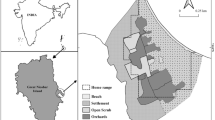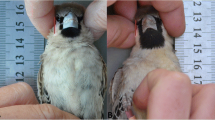Abstract
We studied grooming among adults of a one-male multifemale troop of free-ranging Hanuman langurs (Presbytis entellus)living near Jodhpur, India, for 9 years. The 11–13 females devoted about 6% of their day to allogrooming. Adult males, whose tenures averaged 2.2 years, were transient figures in the troop's history, as reflected by their rather peripheral role in the grooming network. Females groomed males 4–40 times more frequently (1006 episodes) than vice versa- (176 episodes). Adult females received 97% of all grooming from other adult females (6655 episodes). Although females exhibited an age- inversed dominance hierarchy, they did not compete for grooming access to particular troop mates. Dyads of all possible rank differences occurred as frequently as expected: 51% of grooming was directed up the hierarchy and 49% down it. Young, high- ranking individuals gave and received significantly more grooming than the oldest, low- ranking females did. The pattern seemed to be influenced by kin selection because of the presumably high degree of female relatedness. They invested most in troopmates with the highest reproductive value, i.e., the youngest individuals. This trend was coupled with a preference of closest kin (mothers and daughters). Reciprocity was the outstanding feature since all adult females groomed and were groomed by all others. Such a tight social net might establish the necessary cohesion during frequent territorial disputes with neighboring troops.
Similar content being viewed by others
References
Altmann, J. (1974). Observational study of behavior: Sampling methods.Behaviour 49: 227–267.
Barton, R. (1985). Grooming site preferences in primates and their functional implications.Int. J. Primatol. 6: 519–532.
Bishop, N. (1975).Social Behavior of Langur Monkeys (Presbytis entellus) in a High Altitude Environment, Ph.D. thesis, University of California, Berkeley.
Boccia, M. L. (1983). A functional analysis of social grooming patterns through direct comparison with self-grooming in rhesus monkeys.Int. J. Primatol. 4: 399–418.
Boccia, M. L., Rockwood, B., and Novack, M. (1982). The influence of behavioral context and social characteristics on the physical aspects of social grooming in rhesus monkeys.Int. J. PrimatoL 3: 91–108.
Boggess, J. E. (1976).Social Behavior of the Himalayan Langur (Presbytis entellus) in Eastern Nepal, Ph.D. thesis, University of California, Berkeley.
Borries, C. (1989).Konkurrenz unter freilebenden Langurenweibchen (Presbytis entellus), Ph.D. thesis, Georg-August-Universität, Göttingen.
Borries, C. (1992). Grooming site preferences in female langurs(Presbytis entellus).Int. J. PrimatoL 13: 19–32.
Borries, C, Sommer, V., and Srivastava, A. (1991). Dominance, age, and reproductive success in free-ranging female Hanuman langurs.Int. J. PrimatoL 12: 231–257.
Chapais, B. (1983). Dominance, relatedness and the structure of female relationships in rhesus monkeys. In Hinde, R. (ed.),Primate Social Relationships, Sinauer, Sunderland, MA, pp. 208–219.
Clutton-Brock, T. H. (1977). Activity patterns of red colobus(Colobus badius tephrosceles).Folia PrimatoL 21: 161–187.
Davies, G. (1984).An Ecological Study of the Red Leaf Monkey (Presbytis rubicunda) in Dipterocarp Forests of North Borneo, Ph.D. thesis, University of Cambridge, Cambridge.
De Waal, F. B. M., and Luttrell, L. M. (1986). The similarity principle underlying social bonding among female rhesus monkeys.Folia PrimatoL 46: 215–234.
Dunbar, R. I. M. (1991). Functional significance of social grooming in primates.Folia Primatol. 57: 121–131.
Dunbar, R. I. M., and Dunbar, P. (1974). Ecological relations and niche separation between sympatric terrestrial primates in Ethiopia.Folia Primatol. 21: 36–60.
Fairbanks, L. A. (1980). Relationships among females in captive vervet monkeys: Testing a model of rank-related attractiveness.Anim. Behav. 28: 853–859.
Goosen, C. (1987). Social grooming in primates. In Mitchell, G., and Erwin, J. (eds.),Comparative Primate Biology, VoL 2, fart B: Behavior, Cognition and Motivation, Alan R. Liss, New York, pp. 107–131.
Hrdy, S. B. (1977).The Langurs of Abu. Female and Male Strategies of Reproduction, Harvard University Press, Cambridge, MA.
Hrdy, S. B., and Hrdy, D. B. (1976). Hierarchical relations among female Hanuman langurs (Primates: Colobinae,Presbytis entellus).Science 193: 913–915.
Hutchins, M., and Barash, D. (1976). Grooming in primates: Implications for its utilitarian function.Primates 17: 145–150.
Jay, P. C. (1963).The Social Behavior of the Langur Monkey, Ph.D. thesis, University of Chicago, Chicago.
Jay, P. (1965). The common langur of north India. In De Vore, I. (ed.),Primate Behavior —Field Studies on Monkeys and Apes, Holt, Rinehart and Winston, New York, pp. 197–249.
Krusko, N. A. (1990).Social Behavior, Reproduction, and Aging in Captive Female Langur Monkeys, Ph.D. thesis, Berkeley, University of California.
Kurland, J. A. (1977). Kin selection in the Japanese monkey.Contrib. Primatol. Karger, Basel.
Marsh, C. (1981). Time budgets of the Tana River red colobus.Folia Primatol. 35: 30–50.
McKenna, J. J. (1975).An Analysis of the Social Roles and Behavior of Seventeen Captive Hanuman Langurs (Presbytis entellus), Ph.D. thesis, University of Oregon, Eugene.
McKenna, J. J. (1977). Patterns and functions of grooming behavior among the common Indian langur monkey.Kroeber Anthropol. Soc. Papers 50: 3–12.
McKenna, J. J. (1978). Biosocial functions of grooming behavior among the common Indian langur monkey(Presbytis entellus).Am. J. Phys. Anthropol. 48: 503–510.
McKey, D., and Waterman, P. G. (1982). Ranging behaviour of a group of black colobus(Colobus satanas) in the Douala-Edea Reserve, Cameroon.Folia Primatol. 39: 264–304.
Mohnot, S. M. (1974).Ecology and Behaviour of the Common Indian Langur, Presbytis entellus, Dufrèsne, Ph.D. thesis, University of Jodhpur, Jodhpur.
Moore, J. (1984). Age and grooming in langur male bands(Presbytis entellus). In Roonwaal, M. L., Mohnot, S. M., and Rathore, N. S. (eds.),Current Primate Researches, University of Jodhpur Press, Jodhpur, pp. 381–388.
Poirier, F. E. (1970). The Nilgiri langur(Presbytis johnii) of south India. In Rosenblum, L. A. (ed.),Primate Behavior — Developments in Field and Laboratory Research, Academic Press, New York, pp. 254–383.
Reichard, U. (1991).Zum Sozialverhalten einer Gruppe freilebender Weiβhandgibbons (Hylobates lar), M.Sc. thesis, University of Göttingen, Göttingen.
Ripley, S. (1965).The Ecology and Social Behavior of the Ceylon Gray Langur, Presbytis entellus thersites, Ph.D. thesis, University of California, Berkeley.
Ripley, S. (1967). Intertroop encounters among Ceylon gray langurs(Presbytis entellus). In Altmann, S. (ed.), Social Communication Among Primates, University of Chicago Press, Chicago, pp. 237–254.
Rowell, T. E., Wilson, C, and Cords, M. (1991). Reciprocity and partner preference in grooming of blue monkeysInt. J. PrimatoL 12: 319–336.
Sade, D. S. (1965). Some aspects of parent-offspring and sibling relations in a group of rhesus monkeys, with a discussion of grooming.Am. J. Phys. Anthropol. 23: 1–18.
Sade, D. S. (1972). Sociometrics ofMacaca mulatto. I. Linkages and cliques in grooming matrices.Folia PrimatoL 18: 196–223.
Schino, G., Aureli, F., and Troisi, A. (1988). Equivalence between measures of allogrooming: An empirical comparison in three species of macaques.Folia PrimatoL 51: 214–219.
Seyfarth, R. M. (1977). A model of social grooming among adult female monkeys.J. Theor. Biol. 65: 671–698.
Seyfarth, R. M. (1980). The distribution of grooming and related behavior among adult female vervet monkeys.Anim. Behav. 28: 798–813.
Silk, J. B. (1982). Altruism among femaleMacaca radiata, explanations and analysis of patterns of grooming and coaltion formation.Behaviour 79: 162–188.
Sommer, V. (1985).Weibliche und männliche Reproduktionsstrategien der Hanuman-Languren (Presbytis entellus)von Jodhpur, Rajasthan/Indien, Ph.D. thesis, Georg-August-Universität, Göttingen.
Sommer, V. (1987). Infanticide among free-ranging langurs(Presbytis entellus) at Jodhpur (Rajasthan/India): Recent observations and a reconsideration of hypotheses.Primates 28: 163–197.
Sommer, V. (1994). Infanticide among the langurs of Jodhpur — testing the sexual selection hypothesis with a long-term record. In Parmigiani, S., and Vom Saal, F. (eds.),Infanticide and Paternal Care, Harwood Academic, London, pp. 155–193.
Sommer, V., and Rajpurohit, L. S. (1989). Male reproductive success in harem troops of Hanuman langurs(Presbytis entellus).Int. J. Primatol. 10: 293–317.
Sommer, V., Srivastava, A., and Borries, C. (1992). Cycles, sexuality, and conception in free-ranging langurs(Presbytis entellus).Am. J. PrimatoL 28: 1–27.
Sparks, J. (1967). Allogrooming in primates: A review. In Morris, D. (ed.),Primate Ethology, Weidenfeld and Nicolson, London, pp. 148–175.
Srivastava, A. (1989).Feeding Ecology and Behaviour of Hanuman Langur, Presbytis entellus, Ph.D. thesis, University of Jodhpur, Jodhpur.
Srivastava, A., Borries, C, and Sommer, V. (1991). Homosexual mounting in free-ranging female Hanuman langurs(Presbytis entellus).Arch. Sex. Behav. 20: 487–512.
Stanford, C. (1989).Ecology and Behavior of Capped Langurs (Presbytis pileata) in Bangla Desh, Ph.D. thesis, University of California, Berkeley.
Struhsaker, T. T., and Leland, L. (1979). Socioecology of five sympatric monkey species in the Kibale forest, Uganda.Adv. Study Behav. 9: 159–228.
Sugiyama, Y. (1965). Behavioral development and social structure in two troops of Hanuman langurs(Presbytis entellus).Primates 6: 213–247.
Sugiyama, Y. (1976). Characteristics of the ecology of the Himalayan langurs.J. Hum. EvoL 5: 249–277.
Sugiyama, Y., Yoshiba, K., and Parthasarathy, M. D. (1965). Home range, mating season, male group and intertroop relations in Hanuman langurs(Presbytis entellus).Primates 6: 73–106.
Terry, R. L. (1970). Primate grooming as a tension reduction mechanism.J. PsychoL 76: 129–136.
Vogel, C. (1976).Ökologie, Lebensweise und Sozialverhalten der grauen Languren in verschiedenen Biotopen Indiens, Parey, Berlin.
Vogel, C. (1988). Sociobiology of Hanuman langurs(Presbytis entellus): Introduction into the Jodhpur field project.Hum. EvoL 33: 217–226.
Weber, I. (1973). Tactile communication among free-ranging langurs.Am. J. Phys. AnthropoL 38: 481–486.
Winkler, P., Loch, H., and Vogel, C. (1984). Life history of Hanuman langurs(Presbytis entellus) — reproductive parameters, infant mortality, and troop development.Folia PrimatoL 43: 1–23.
Author information
Authors and Affiliations
Rights and permissions
About this article
Cite this article
Borries, C., Sommer, V. & Srivastava, A. Weaving a tight social net: Allogrooming in free-ranging female langurs (Presbytis entellus). International Journal of Primatology 15, 421–443 (1994). https://doi.org/10.1007/BF02696102
Received:
Revised:
Accepted:
Issue Date:
DOI: https://doi.org/10.1007/BF02696102




